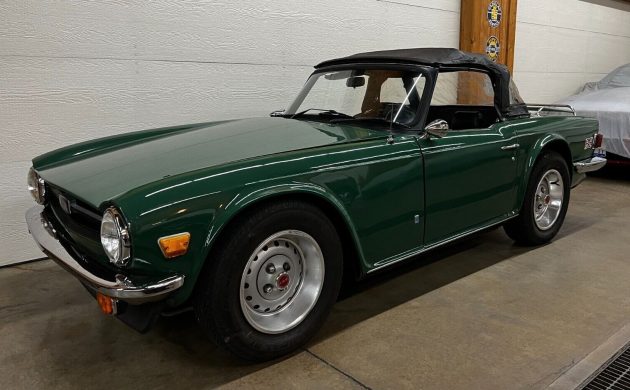
It is funny how some classics barely rate a sideways glance for some enthusiasts while others create such an indelible impact that they remember the first time they saw one. Such was the case with me and the Triumph TR6. I was a young teenager when I spotted my first one, “in the flesh,” I admit that it was love at first sight. Defining the attraction is difficult, although the aggressive styling and purposeful wheels are likely reasons. This 1976 TR6 is an unmolested survivor that the seller has listed on behalf of a friend. It isn’t perfect, but it could be ideal for an enthusiast seeking a driver-grade British classic. The Triumph is listed here on eBay in Sylvania, Ohio. Bidding sits below the reserve at $4,350, with time remaining for interested parties to stake their claim.
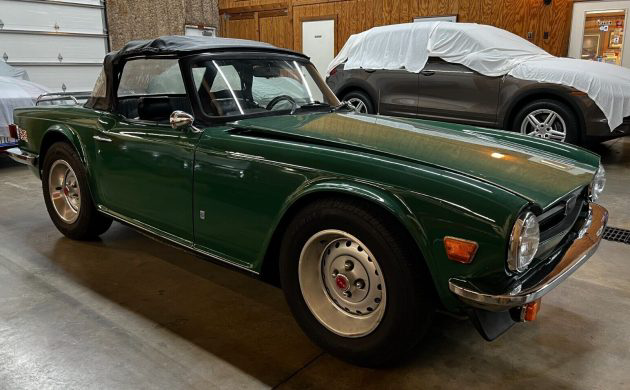
Triumph introduced the TR6 for the 1969 model year as the successor to its TR250 and TR5 models. The body was styled by Karmann of Germany and is a more aggressive derivation of its predecessor’s lines. Sources vary on the final production total, although figures of around 91,800 are often quoted. Most were exported, with North America the most common destination once cars rolled off the line in Coventry, England. The original owner ordered this TR6 in British Racing Green, possibly the most iconic shade to grace a British sports car. The current owner purchased the car a few years ago from a Florida-based enthusiast, and the favorable climate has left this gem rust-free. The exterior is clean, while the underside shots reveal no nasty surprises. The paint holds a healthy shine, and the lack of significant flaws in it or the steel reinforces that potential buyers can consider it a driver-grade vehicle. The Black soft-top is free from rips, the glass is clear, and the trim is in excellent condition. The wheels are the exterior’s crowning glory, enhancing the TR6’s aggressive styling. These are free from stains and marks.
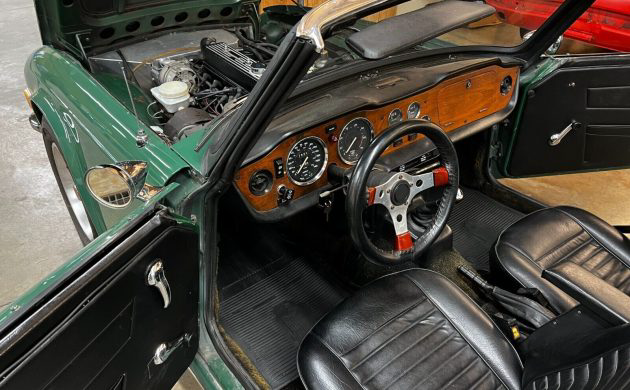
The positive vibes continue inside this Triumph because the only item the new owner must secure for excellent presentation is a new carpet set. These retail for around $250, and with the lack of wear on the Black upholstered surfaces, would provide the ideal finishing touch. The dash timber looks fantastic, and the pad is free from UV damage. The driver’s view through the thick leather-wrapped wheel is dominated by a speedometer and tachometer, which is as it should be in any British sports car.

British sports cars typically provide an engaging motoring experience, although engine power tends to be relatively modest. The 1976 Triumph TR6 is no exception, with its 2.5-liter straight-six producing 101hp and 128 ft/lbs of torque. This feeds to the rear wheels via a four-speed manual transmission, although I don’t believe this car features the optional overdrive. Those figures don’t sound like a recipe for excitement, and they probably wouldn’t be if the car didn’t weigh a mere 2,624 lbs. It will never threaten muscle cars for outright acceleration, but the low center of gravity should allow this TR6 to run rings around them on twisting tarmac. The seller states that the current owner recently replaced the clutch, slave cylinder, rear shocks, and other components. This gem is a turnkey proposition, ready to hit the road in time for some summer fun.

I have often longed to park a Triumph TR6 in my garage, but the planets have never aligned for that to happen. Therefore, I will envy someone in a few days as they become the new owner of this 1976 example. The timing couldn’t be better because we have just passed the Spring Equinox. That means the days will become longer and warmer, maximizing the chances for the buyer to slip behind the wheel of this beauty to enjoy the best of what Mother Nature has to offer. If you suddenly feel very tempted, I can hardly blame you. We’re told we shouldn’t yield to temptation, but maybe you can this time.




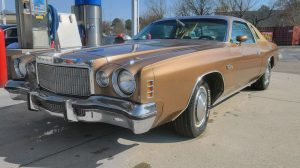
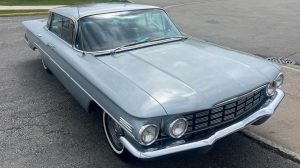
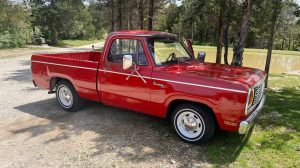
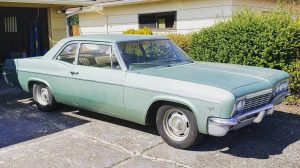


Beautiful car! Got experience with these cars from the shop and building a couple autocross cars. I’m a long time TR 4 fan but the transformation into the 6 is well done. They have a clutch only a body builder would love but they are fun to drive.
Always a favorite (especially in BRG), these sold a lot of Spitfires when dealers marked them up. Good looking car at a (later) somewhat affordable price and performance was good for what you bought.
This one is obviously a driver but no glaring issues tho cleaning up or replacing the carpet might be a consideration.
More than reasonable price-right now, anyway. Let’s see where it goes.
GLWTA
especially nice w/o the rather ugly post 73 bumpers. I paid 4241 for my 73- out the door- with OD.carmine with tan interior. 100k on it in 10 years with no major problems, even electric. Post divorce my ex sold it for 5.00 to her brother who wrecked it soon after. alas.
I was shopping for a new on back when these were new, after driving few used ones 70-71’s I was really disappointed with how the then new smog regulations had just killed off the power. I tried to buy an older model but here in midwest they were old mostly rust buckets with major damage from people driving them on the salt covered roads. It seemed also that all of them needed quite a bit of mechanical attention back then, so if you buy one of these and want to drive it be prepared to become familiar with the mechanical and electrical systems. Remember Lucas electrics,”Prince of Darkness”.
I guess I’m a cheap skate because bidding is at $7200 and still hasn’t cracked the reserve and its $2,200 over what I think it’s worth nice little car
Yeah, a pretty nice TR6 for $5k is pretty unlikely at this point, or at any point in recent history. I’d love to have this one.
Just like there sellers that wildly overvalue their cars, there is an equally large number that wildly undervalue classic cars. They remember when these cars had very little and that has stuck with them. The problem, in my opinion is when people equate what they would pay to the cars actual worth, they are not the same and never have been.
Value is not determined by asking price, but by selling price, which is often unknown. People like to complain about auctions prices, yet they account for only a small fraction of sales. There are good deals out there for people that put in the work to find them and are willing to consider a broad range of cars consisting of makes, models, color, drivetrain. As the list contracts, the cost goes up. That’s how things have always worked. Me and most of my friends were doing that since the early-80’s, when we we realized we couldn’t afford the cars at the top of our “want” list and were faced with the reality of our budget. The internet has made finding cars for sale easier than ever, yet you never see mentioned that the best deals are rarely advertised, they are typically found via word of mouth, that hasn’t changed.
Steve R
Ha, ha… by the way, its 2024 not 1984…
This is what I like… A TR-6 driver! Looks like nice example, too! It should be driven. too. I always liked the TR-4 and 250 the best. In my early years, I alway drove MGB-GT’s and Spridgets and never had the time or money to get a Triumph. I like the TR-6 but the only problem I ever had with them was when I would attend a British car meet. There were always so many TR-6’s that were over restored that it looked like a new car dealer lot. Those cars didn’t come out of the factory that nice! I never wanted to look at them because they all looked the same!! Nothing personal, I just like some patina in an older Brit sports car! Good TR-6’s seem to be in the $15–18K range lately. With all the funny money around this one could crack the $15 K range. No for me though. It will be a fun watch!!
I found the TR-6 to be the “top dog” among British sports cars of this era, superior to both the MGB and its successor, the TR7/8 twins. It’s the British version of 1960’s American muscle cars, in that parts are plentiful and relatively cheap, including new frames and complete body shells! It’s literally possible to build a new TR-6 from the ground up, using aftermarket replacement parts. In addition to the frames and bodies, aftermarket conversion kits exist for four-wheel disk brake conversions, Ford and Rover V8 engine swaps, five-speed gearboxes, limited-slip differentials and Electronic Fuel Injection (EFI), replacing those difficult to synchronize SU-clone Stromberg carburetors!
Now if someone would develop a 24-valve DOHC cylinder head for that straight-six engine, we’d be all set!
Or if you’re building your own, use the Rover V8!
The carbs are totally set up as emission control units. Solved that problem by installing a pair of same size SUs.
Years ago I remember in one of the classic car mags an article where they compared the TR6 and MGB… and there was one line I’ll always remember because as the current owner of one each I can vouch that it is quite accurate… the best I can remember it… “pushed hard, the MGB with its unit construction feels as one piece, while the TR6 feels like a bunch of parts in close formation”…
That may be true, but the MGB, with its four-cylinder engine and solid-axle rear end, was inferior to the TR-6’s IRS setup and straight-six engine. Many of the TR-6’s issues can be cured by replacing the stock frame with an aftermarket piece. The factory frame was fabricated by welding two (2) U-channels together, but the seam was only spot welded, not continuously welded, so the frame could flex and water could enter through the un-welded sections of the frame, causing internal rust and eventual failure. The aftermarket frames are made from box section square tubing, which is much stronger and stiffer. Some vendors powder coat their frames and fill the frame tubing with closed-cell foam insulation, to act as a sound deadener and keep water out of the inside of the frame.
Like Adam, I can actually remember my first TR-6 sighting ever! My family and I were living in Spain at the time, and one sunny day in May or early June of 1971 I was waiting for the school bus, along with dozens of other kids. I was still twelve–a couple of months away from turning thirteen. A navy blue TR-6 with British licence plates and the top down passed by. Its good looks and deep-throated growl made quite an impression on me! Bear in mind that in Europe back then, TR-6s were petrol-injected with 150 bhp–not the 102 bhp available in North America, thanks to Ralph Nader and his ilk…
I never understood why the North American examples never got fuel injection, as EFI would have done wonders for meeting the 1970’s era EPA anti-smog rules. On the other hand, maybe it was for the best, with Lucas supplying the electronics for Bosch K-Jetronic components, LOL!
As an owner of many British cars and motorcycles over the years I’ve come to realize only non owners or non mechanical inclined owners needing a scapegoat complain about Lucas electrical.
Like Adam, I can actually remember my first TR-6 sighting ever! My family and I were living in Spain at the time, and one sunny day in May or early June of 1971 I was waiting for the school bus, along with dozens of other kids. I was still twelve–a couple of months away from turning thirteen. A navy-blue TR-6 with British licence plates and the top down passed by. Its good looks and deep-throated growl made quite an impression on me! Bear in mind that in Europe back then, TR-6s were petrol-injected with 150 bhp–not the 102 bhp available in North America, thanks to Ralph Nader and his ilk…
Always wanted one but never bought one. Worked at a Chevy dealer around 1980 and drove a couple that came in on trade. Nice ones now are still affordable in the $20’s. Unfortunately my aging joints make driving a stick shift now an unpleasant experience so I’m limited to something automatic. This one will be a fun driver for the lucky bidder.
Robert: North American examples of the TR-5/250 and TR-6 did not get petrol injection because the motors were NOT quite the same as their non-North American counterparts. Most people in the States think the engines were identical except for injection versus twin Zenith-Stromberg carburettors. Not so! For Britain and everywhere else outside of North America, you had higher lift cams and higher compression (10,5:1 or 10:1 depending on the year). This, combined with mechanical injection and the fact that HEI and computer management had not been invented yet in 1968-69, meant that there was no way American emission numbers could be met.
As for your Lucas comments, I agree with BillC below. I have owned MANY English sports cars over the decades, and they have never given me more electrical problems than utilitarian American and Japanese cars. My current sports car is a very original ’69 E Type Jaguar roadster. Its 55 year-old wiring is still holding up well and no one seems to ever have messed around with the electricals…which is why I suspect everything works like a Swiss watch. In my opinion, Lucas-bashing in the United States seems to have become a sport that has taken on a life of its own–out of proportion with reality and any semblance of competent maintenance.
Oh come on who doesn’t want a “Lucas Prince of Darkness” T shirt.
Seriously though properly maintained nothing wrong with Lucas.
When I see the shirt you mention, it tells me the owner is happy being one of the followers of a cool guy, but has no direct experience with the subject. Or, he is the cool guy displaying the scapegoat for inability.
Much like the VW Beetle, Bosch K-Jetronic fuel injection at the time was electronically controlled, but not digitally controlled, there is a difference. The electronic controls were analog, not digital, but did offer some level of control beyond the purely mechanical Bendix system seen on early Corvettes.
As for Lucas electrics, I think at least part of the reason for their poor reputation, deserved or not, may be related to the fact that British cars retained six-volt, positive-ground electrical systems long past the time that the rest of the industry had converted to the twelve-volt, negative ground standard. American car owners, used to the newer twelve-volt standard, were unfamiliar with the eccentricities involved with positive-ground electrical systems, and often suffered issues as a result of that ignorance. In addition, the shift from generators to alternators in the mid-1960’s also played a role, as again, the British manufacturers were late to the party in adopting alternators as standard equipment. Alternators, with their higher power output at idle, solved a lot of issues that had plagued car owners for decades prior to the upgrade, and may have been another factor in the issues experienced by British car owners.
As for the internal differences for fuel-injected cars versus their carbureted brethren, there’s nothing that would prevent the use of fuel injection with a lower output engine, such as the one used on North American cars. The Constant Injection System (CIS) as implemented by Bosch in the K-Jetronic system used by VW and Porsche, et al, would have offered significant emissions improvements over carburation. Not as significant as modern single-point, digitally controlled systems, perhaps, but still far superior to the carburetors of the era. Emissions was the primary driver for the VW Super Beetle receiving a Bosch K-Jetronic system in 1976. The lower compression ratios and lower lift cam seen in North American examples of the era were a direct result of the attempt to control Nitrogen Oxides in exhaust emissions, combined with the lower octane rating of the early unleaded gasoline of this time period. European drivers wouldn’t get to experience the “pleasure” of unleaded gasoline for some years after North American drivers were “Introduced” to unleaded gasoline starting in 1975.
Ah yes… the spotty reputation of Lucas electrics… some of it deserved, most of it not… and more often than not, the result of desperate, ohms law challenged, but well-meaning shadetrees. In an era passed, before these little British things became collectables, they were bought to be used daily and just to have fun with… mostly by the young, with limited mechanical ability and even less financial means. So maintenance was often deferred… with predictable results. The comparatively large, lumbering Detroit products were indeed more tolerant of the bailing wire and duct tape repairs so the reliability reputation of the Brits suffered by comparison… then this was all made worse by the arrival of Japanese products, which never broke no matter how badly they were neglected. Now, for the specifics of Lucas… after 40+ years of British car ownership and just as many years as a degreed electrical engineer, I can attest the problems encountered are not due the componentry… by that I mean switches, alternators, gauges, etc… Lucas’ quality was just as good as AC-Delco, Bosch, Motorcraft, etc., etc… However, where the Brits fell down was with all the connections in between. The wiring harnesses and connectors were probably some of the worst engineered out there… then time and weathering compounded the problems. Virtually all electric issues I’ve encountered on my MGs and Triumphs, outside of decades old and worn out starters or alternators, were failed electrical connectors. But the real crime was that nothing was ever done to improve things… I can only guess this was due to how cash strapped the British auto industry was in the, ‘60s and ‘70s. The result was that – for many – “LUCAS” became an acronym for (L)oose (U)nsolder (C)onnections (A)nd (S)plices.
To be fair, British cars weren’t the only cars with electrical gremlins. My 1985 VW Jetta had some serious electrical issues, largely due to the lousy design of the “Master” connector under the dash that a majority of the circuits in the car passed through, combined with wiring that was slightly undersized for many of the circuits. The VW used European wire, sized in millimeters, as opposed to the American Wire Gage (AWG) specified in North American cars, and the sizes VW used aways seemed to be just a “hair” smaller than the wire used on the same circuit in an American car, with predictable results, as circuits in my VW seemed to be more susceptible to failure due wires overheating and becoming brittle with age.
US $11,900.00
52 bids Ended Sunday, 06:02 PM
Reserve not met
Condition:
Used